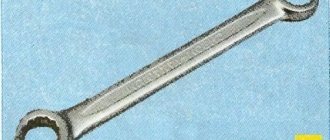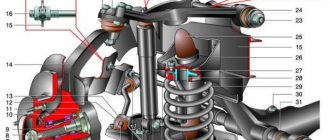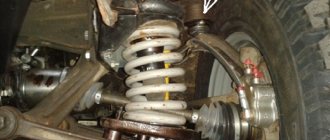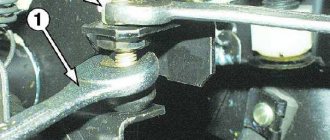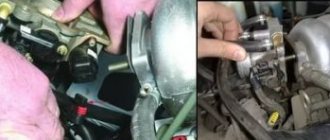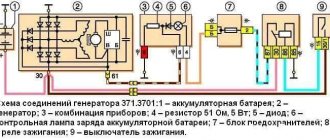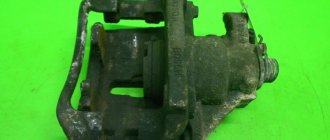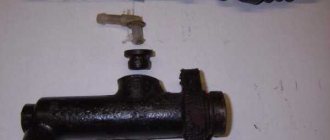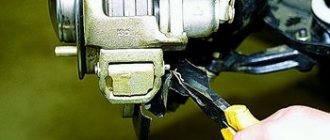Pumping the clutch on a Niva: procedure
Bleeding the clutch drive on cars before 2009 and after is performed in the same way.
If, when you press the pedal all the way, the clutch does not disengage completely (“clutch engages”), which is accompanied by a characteristic grinding of gears when engaging reverse gear, then there is probably air in the clutch hydraulic drive. Requires pumping.
In addition, bleeding must be done after replacing the fluid or when changing clutch parts, which is carried out with depressurization of the system.
We carry out the work on a lift or inspection ditch.
Check the fluid level in the clutch hydraulic reservoir and add fluid if necessary.
Remove the cap from the working cylinder fitting.
We put a transparent plastic hose on the fitting, the end of which is lowered into a container with brake fluid.
Using an “8” wrench, unscrew the fitting 1/2–3/4 turn.
In this case, the assistant sharply presses the clutch pedal and releases it smoothly until the air bubbles released from the hose disappear.
With the clutch pedal pressed, tighten the fitting, remove the hose and put on the cap.
Clutch bleeding should be done when the clutch is not fully engaged.
The basics of bleeding the clutch in the video below:
conclusions
Knowing these points, you can independently determine the quality of the clutch and, if necessary, pump it.
Tools:
- Split spanner 8 mm
- Split spanner 10 mm
- Brake fluid container
Parts and consumables:
- Brake fluid
- Bleeding hose
- Rags
Note:
According to the manufacturer's recommendation, the working fluid in the clutch release hydraulic drive must be replaced after 2 years.
If, when the pedal is pressed all the way, the clutch does not disengage completely (“drives”), which is accompanied by a characteristic grinding of gears when engaging reverse gear, there may be air in the clutch hydraulic drive. Remove it by bleeding the drive.
In addition, pumping is performed when the hydraulic drive is filled with fluid after its replacement or after repair of system components associated with its depressurization.
Carry out the work with an assistant in the inspection ditch.
1. Remove the protective cap from the clutch slave cylinder bleed valve.
How to determine the need to bleed the clutch
This can be determined because when you engage any gear, you will hear a grinding noise in the box.
This situation may indicate that air has appeared in the system. This can happen as a result of replacing both the fluid itself and system parts.
To do this work yourself, you should have a set of tools, replacement fluid, an empty container and a tube. It will be convenient to carry out the work with an assistant. Pumping should be done on an inspection hole or overpass.
Useful tips
You should not constantly keep your foot on the clutch pedal while the car is moving.
In this case, the disc will slip and wear out faster. And also the release bearing will work under load, as a result of which its life will be reduced. For the same reason, you should not keep the clutch pedal depressed for a long time. This can happen, for example, in a traffic jam.
When should it be adjusted?
It is necessary to adjust the pedal free play and pump the hydraulic drive in the following cases:
- Pedal travel is too long. In this case, the clutch does not disengage completely (“drives”). This leads to difficult gear shifting and intense wear of the friction lining on the driven disk.
- Small clutch travel. In this case, the disc slips, especially under heavy load on the transmission (driving uphill, in high gear).
- Jerking, knocking or squeaking noises when changing gears or when the car starts moving.
Important: operating a car with an incorrectly adjusted or “aired” clutch drive leads to accelerated wear of gearbox parts.
The design of the Chevrolet Niva clutch coincides with a similar unit of the “classic” AvtoVAZ. The only difference is in the different dimensions of the working cylinder and, accordingly, in a larger and easier pedal stroke.
Sequencing
How to bleed the clutch on a Niva? It is better to carry out repairs to the hydraulic clutch drive on an overpass. First, you need to check the hydraulic drive elements for leaks. Then the fluid level in the tank is checked. It is located in the engine compartment. If necessary, add liquid. At the same time, debris and other foreign impurities should not get into the tank. Then the clutch itself is adjusted. Only after this can you start pumping. An assistant is needed for this work. If it is missing, a gas stop is required to fix the clutch pedal. Remove the protective cap from the working cylinder fitting. Then one end of a transparent silicone hose is put on it. Its other end is lowered into a container with brake fluid. The tightening of the fitting is loosened several turns with a key of eight. After this, air will begin to come out of the hose along with the liquid.
The assistant sits behind the wheel, sharply presses the clutch pedal several times and releases it. The interval between presses is approximately 3 seconds. This action stops only when liquid comes out of the hose without air bubbles. Fluid is then added to the clutch reservoir. With the pedal pressed, screw in the fitting and put on the cap. After this, the clutch system is checked. When the gearbox is operating, no extraneous sounds should be heard. At high speeds the car should accelerate dynamically. This completes the repair.
Replacing power steering fluid (oil) (checking level) Niva VAZ 21213, 21214, 2131 lada 4×4
The fluid poured into the power steering hydraulic drive is designed for its entire service life, so the manufacturer does not give any instructions on the frequency of its replacement. However, the fluid is replaced if it becomes excessively contaminated or if water gets into it. It is also necessary to regularly check its level every time the car is serviced. A drop in the liquid level indicates depressurization of the system and requires mandatory inspection and elimination of leaks in places of loose connections
(Note: If your car is under warranty, then topping up, troubleshooting, or replacing the fluid is carried out at a Lada dealer)
Manufacturer's hydraulic fluid
Brand: Pentosin Hydraulik Fluid CHF 11S-TL VW52137. Manufacturer: Pentosin Werke AG, Germany
Fill the power steering system only with fluid recommended by the manufacturer.
How much fluid is in the power steering reservoir? - 1.7 liters.
Level check
The power steering barrel is located in the left front corner of the engine compartment. The check is performed on a flat, horizontal surface, with a cold engine.
Unscrew the reservoir cap counterclockwise...
...and remove the tank cap, which is the level meter (dipstick)
The fluid level should be between the two marks on the reservoir cap indicator.
If the fluid level in the tank is below the lower line, add fluid to the level of the upper line.
Fluid replacement
1. Remove the tightening bolt of the power steering reservoir clamp.
2. and remove the clamp
3. remove the cap from the tank
4. Remove the reservoir from the bracket and drain the liquid from the reservoir into a suitable container.
5. Loosen the low pressure hose clamp.
6. Remove the hose.
7. To prevent fluid from leaking out, plug the hole in the tank fitting and lower the end of the low pressure hose into a container for drained fluid. Start the engine and, turning the steering wheel from lock to lock in both directions three or four times, drain the old fluid while adding new fluid. Repeat the operation until fresh fluid appears from the low pressure hose.
And also interesting: Buy Lada Bronto (Lada 4X4 Bronto) in Kirov: price, in stock, car showroom, official dealer Inkom-Avto
Warning: Carefully monitor the fluid level in the reservoir; do not allow air to enter the power steering pump - this may damage the pump.
8. Install the tank in the reverse order of removal.
9. Add fluid to the level of the upper mark on the dipstick of the reservoir plug
10. Bleed the power steering system
Video
Signs of air in the system
The presence of air in the hydraulic drive is indicated by the following signs: when you press the pedal, the clutch does not disengage completely; when you turn off the reverse speed, a characteristic grinding noise is heard. To work, you will need a set of tools, a small container, a hose and brake fluid. This procedure is practically no different from bleeding the brake system. Therefore, even a novice motorist can handle it. You must use the fluid recommended by the car manufacturer.
How to bleed the clutch on a Niva 2121
Directory
Tags
Removing, replacing, installing anti-roll bar
Removing, replacing, installing timing belt
Removing, replacing, installing rear suspension shock absorber spring
Inspection, checking the steering
Removal, replacement, installation of the crankshaft and its bearings
Symptoms: the clutch pedal has become soft and periodically fails.
Possible cause: air has entered the clutch hydraulic drive.
Tools: elastic tube, container, set of keys.
Note. You should check the reliability of fastening of the connections, the presence of cracks in the tubes or leaks in the connections. Air may also leak through the O-rings of the master or slave cylinders.
1. Check the brake fluid level in the hydraulic drive reservoir and bring it up to normal, if necessary.
2. Place a hose on the fitting of the working cylinder and load it into a container with brake fluid.
Note. The end of the pumping hose must be constantly in the liquid.
3. Unscrew the fitting about a quarter of a turn. After this, sharply press and smoothly release the pedal until you notice that air bubbles no longer come out of the hose.
4. Press the pedal, tighten the fitting as far as it will go and remove the hose, then put on the fitting cap.
Note. After pumping, you need to bring the brake fluid level in the reservoir to normal.
Dear customers, in order to avoid errors when sending the URBAN clutch slave cylinder, indicate the metal or plastic cylinder, model and year of manufacture of your car in the “Comment” line.
At 21214m - NIVA Urban from 2021. They began to install a hydraulic clutch (GCS+RCS) Valeo, a hose with quick releases. It is made of plastic, and the whole thing, body, piston, rod, everything is plastic.
– 21214-1602610-00 main cylinder of the clutch hydraulic drive (MCS);
– 21214-1602510-00 clutch slave cylinder (RCS);
– 21214-1602692-00 plastic tube, there is also a second number in the catalog 21214-1602602-10.
Clutch and its hydraulic drive: 1 – clutch release fork; 2 – bracket; 3 – working cylinder of the hydraulic clutch; 4 – fitting for bleeding; 5 – central diaphragm pressure spring; b – pressure disk; 7 – flywheel; 8 – damper spring; 9 – driven disk; 10 – tube; 11 – clutch housing; 12 – main cylinder of the hydraulic clutch; 13 – hydraulic clutch reservoir; 14 – clutch pedal; 15 – gearbox input shaft; 16 – rear bearing of the input shaft; 17 – guide sleeve; 18 – clutch release bearing clutch; 19 – clutch release bearing; 20 – ball support for the clutch release fork; 21 – front bearing of the input shaft; 22 – casing; 23 – pusher
The main advantage of the plastic parts of the hydraulic clutch drive (GCS+RCS) of Valeo on 21214m - NIVA Urban - is that the plastic does not require mechanical processing and the necessary roughness of the cylinder and piston surface is ensured in the casting. This technology eliminates production risks associated with the processing of cylinder bodies and pistons and increases the service life of the clutch hydraulic drive. Also, the new hydraulic clutch drive is easier to install in production, since threaded connections are eliminated.
Previously there was a metal tube and a rubber hose with threaded connections, but now it is a single plastic tube that is mounted on the clutch slave and master cylinders using a quick-release connection.
When the clutch pedal is pressed, the piston of the master cylinder moves and transmits pressure through the working fluid to the piston of the working cylinder Lada 4x4 Urban VALEO (РЦС 21214-1602510-00), which acts through the pusher on the fork and clutch release clutch.
What's better here?
For the first time, the Niva VAZ-2121 was modernized in its fifteenth year of life.
Then, in 1993, it was replaced by the carburetor model 21213, which soon turned into the injection model 21214. In August 2009, production of the third generation Niva began (trademark - Lada 4x4). Now we have before us “Lada 4×4 21214-046”. Outwardly, it is the same as its predecessor, but there are a lot of technical differences. It was possible to improve driving performance, higher comfort, reliability, some components and parts were unified with the Chevrolet Niva.
https://www.youtube.com/watch?v=ZuKtyTnKEHA
We talked about preliminary plans for modernization a year ago, in ZR, 2008, No. 9 - now let’s see what of the plans was embodied in the hardware.
Let us remind you that the engine, which now complies with Euro III or Euro IV standards (depending on the configuration), remained without major changes - reliable gaskets with silicone rollers and a water pump with an improved oil seal were used.
The fuel filter has been moved under the body - there are fewer pipes, reducing the likelihood of a fire in the engine compartment. The flywheel, as planned, has a diameter increased to 215 mm. And, of course, the Valeo clutch along with the slave cylinder and automatic freewheel adjustment. As a result, pedal force is reduced by 40% and free play adjustment is no longer necessary as wear occurs.
Particular attention was paid to coordinating the characteristics of the front and rear suspensions. The energy intensity and service life of the front suspension have been increased. The lower ball joints are 2123, the upper ones are 21214, they have a forged body and a larger pin swing angle.
The consequence of the changes was the track widened to 1440 mm. To “expand” the dynamic suspension travel, the compression and rebound buffers were shortened by 10 mm.
Modernization of the chassis made it possible to improve handling, smoothness and stability - in fact, the entire range of driving qualities of the Niva.
At the next stage (in six months to a year) there will be new door trim and body side panels, a redesigned rear seat with an ISOFIX child seat mounting system, CV joints in the driveshafts and improved interior sound insulation.
Main signs of clutch failure
In the new Chevrolet Niva, the clutch does not cause any complaints. But over time, the friction surfaces of the disc wear out, the fatigue strength of the clutch fork decreases, and the seals age and crack.
As the vehicle is used, the surface of the friction discs wears out.
Signs that your car's clutch is in poor condition include the following::
- the clutch “slips” and heats up due to its incomplete engagement due to wear of the friction linings, oil and dirt getting on their surface;
- the clutch “leads” due to its incomplete disengagement due to air entering the hydraulic system, loosening of the rivets of the friction linings, warping, misalignment and end runout of the driven or pressure plate;
- characteristic noises and knocking are heard when pressing or releasing the clutch pedal due to a malfunction of the release bearing, deformation or breakage of other clutch parts.
All this indicates that the clutch system should be disassembled and repaired, and in case of serious malfunctions, the worn clutch should be replaced with a new one.
Which clutch is better to install on a Chevrolet Niva?
We can recommend various types of clutches from different companies, which differ in manufacturing and assembly quality, reliability and, accordingly, price:
- The SACHS clutch from the reputable German concern ZF is of high quality, therefore does not require periodic maintenance, does not have environmentally harmful asbestos linings, and guarantees a mileage of 100 thousand kilometers. The difficulty when purchasing is the high price, since “you have to pay for quality”!
SACHS clutch kit.
VALEO clutch kit.
LUK clutch kit.
Clutch kit VAZINTERSERVICE.
Other clutch options with a good reputation are also possible: FSO (Poland), HOLA (Holland) and others. But beware of Chinese or Turkish counterfeits.
Clutch malfunctions and ways to eliminate them
Incorrect clutch drive adjustment (no pedal free play) Adjust the drive
Oiling of the flywheel, pressure plate, friction linings of the driven disk
Thoroughly wash oily surfaces with white spirit or gasoline and wipe them dry. Replace the heavily oiled driven disk. Eliminate the cause of oiling (oil leakage through the engine and/or gearbox oil seal)
Severe wear or burning of the friction linings of the driven disk
Replace the driven disk assembly
Reduced diaphragm spring force
Replace the pressure plate assembly with the clutch housing (“basket”)
Jamming of the driven disk hub on the splines of the input shaft of the gearbox
Clean the splines from dirt, remove minor damage with a file. If the splines are significantly worn or damaged, replace the transmission disc and/or input shaft. Before assembly, apply Litol-24 or CV joint lubricant to the splines
Clutch master cylinder compensation hole clogged
Disassemble the master cylinder, wash and clean the parts. Replace its seals and hydraulic fluid
The piston of the clutch master cylinder slowly returns to its original position due to swelling of the rubber seals
Replace the cuffs or cylinder assembly. If you suspect gasoline or other solvents have gotten into the clutch fluid, replace it
Incorrect adjustment of the clutch drive (full pedal travel is short, its free play is increased)
Air has entered the hydraulic drive system (the pedal is “soft”)
Bleed the system, tighten connections. If there is a leak from the master or slave cylinders, replace their cuffs or cylinder assemblies
Clutch release fork is deformed
Loosening of rivets or breakage of friction linings, warping of the driven disk (end runout more than 0.5 mm)
Severe and uneven wear, scoring on the working surfaces of the flywheel or pressure plate
Grind or replace the flywheel. If the surface of the pressure plate is damaged, replace the housing with the pressure plate assembly (“clutch basket”)
Distortion or warping of the pressure plate
Replace the housing with the pressure plate assembly (“clutch basket”)
Jamming of the driven disk hub on the splines of the input shaft of the gearbox
Clean the splines from dirt, remove minor damage with a file. If the splines are significantly worn or damaged, replace the transmission disc and/or input shaft. Before assembly, apply fresh Litol-24 or CV joint lubricant to the splines
Loosening of the rivets of the connecting plates of the clutch housing or diaphragm spring, breakage of the plates
Replace the housing with the pressure plate assembly (“clutch basket”)
Release bearing jammed
The clutch release fork is severely deformed or broken
Air in the hydraulic drive system
Bleed the system, tighten connections. If there is a leak from the master or slave cylinders, replace the cylinder assemblies
Heavy wear and defects in the master cylinder mirror; dirt in the cylinder
Worn or defective master cylinder cuff
Replace the cylinder assembly
Jamming of the driven disk hub on the splines of the input shaft of the gearbox
Clean the splines from dirt, remove minor damage with a file. If the splines are significantly worn or damaged, replace the transmission disc and/or input shaft. Before assembly, apply CV joint grease or Litol-24 to the splines
Driven disk deformation
Loose fastening of the friction linings of the driven disk, severe wear or cracks on the linings
Loss of elasticity of the spring plates of the driven disk
Significant settlement or breakage of torsional vibration damper springs, wear of windows for springs
Seizures on the working surfaces of the flywheel or pressure plate
Grind or replace the flywheel or clutch housing with pressure plate assembly (clutch basket)
Significant settlement or breakage of torsional vibration damper springs, wear of windows for springs
Driven disk deformation
Loose fastening of the friction linings of the driven disk, severe wear or cracks on the linings
Worn release bearing or lack of lubrication
Worn front bearing of the gearbox input shaft (at the end of the crankshaft) or lack of lubrication
Plastic pedal bushings not lubricated
Lubricate the bushings with Litol-24 or CV joints-4
The plastic pedal bushings are severely worn
Replace the bushings; before installation, lubricate them with Litol-24 or CV joint-4
Air in the hydraulic drive system
Bleed the system, tighten connections
The return spring of the pedal and/or clutch fork has lost elasticity or is broken
Replace the spring(s)
replacing the Niva clutch slave cylinder
The clutch master and slave cylinders can also cause big problems. I had a leaky clutch giving the effect of the clutch sticking. Sometimes it was impossible to turn off the transmission, sometimes to turn it on. We remove the front cardan, we have already removed it. The flange of the front gearbox is visible, i.e. if the cardan was in place, it would be impossible to unscrew the rcs. Bolts 13, two pieces. It is advisable to photograph the mount itself as it stood. And then (six hours later) I twist it in my hands and can’t remember how it stood.
The cylinder is covered in snot, it’s obvious that it’s dead. Code to buy new 2101-1602515
That's it, the cylinder is removed, the new one is installed in the reverse order. But first I also changed the main one, it goes higher up the hose.
Pull the clutch cable
On Niva I try to buy everything from the factory, from Lada-Image in blue and white boxes. New slave and master cylinders.
Clutch adjustment on Niva 21214
As always, the search for optimal solutions and answers to questions will begin with terminology. What is clutch? This is an intermediate link between the power unit and transmission.
The principle of operation of the mechanism, in general terms, is that it briefly disconnects the power unit from the gearbox. This ensures smooth mating of transmission elements when shifting gears and dampening of vibrations. The manual transmission is thus protected from unnecessary overloads and, accordingly, increased wear.
Structurally, the friction clutch, as the unit that transmits torque from the engine flywheel is also called, has a whole set of differences. It can be electromagnetic, frictional and hydraulic.
And also “dry”, when the clutches operate without lubrication, and “wet”, when the working elements of the clutch operate in transmission oil. There are permanently and non-permanently closed mechanisms, as well as one, two or multi-disc clutch designs.
Finally, this element can be with a central spring or with several springs arranged in a circle on the pressure plate. The clutch can be either two-threaded or single-threaded.
We will not dive deeper into this ocean of technological delights, since we are interested, first of all, in the question of which clutch is better for the Niva 2121. Let us also pay attention to this car unit in relation to the Chevrolet Niva SUV.
Clutch can be: frictional (such a mechanism transmits torque due to friction forces and is the most common), electromagnetic (the interaction of its elements is subject to the action of a magnetic field), hydraulic (fluid flow ensures the operation of its individual components in such a friction clutch).
We find possible problems and fix them
Below we list the main signs that it’s time to worry about finding a solution to the problem: which Chevy Niva clutch is better. Our list of the main malfunctions of this unit, of course, is not closed; other misunderstandings arise that can complicate the life of the driver, but they are due to special cases, and we present the most common problems:
Incomplete engagement or slipping
Incomplete engagement or slipping of the clutch should immediately alert the driver. The first sign of such a disease is that when driving in 3-4 gears, there is a slight increase in speed when the gas pedal is pressed, as they say, “to the floor.” Leave everything as is, and after some time, due to the fact that one disk slips, and all structural elements are constantly heated from friction, the driven disk will easily move, and the pressure wheel and flywheel may crack.
This deficiency can be “cured” by adjusting the pedal stroke. Inspection and, as an option, replacement of the driven disk may help:
Insufficient shutdown
Insufficient clutch release is the second unpleasant factor. Even with the car stationary, is shifting into gear accompanied by a noticeable crunching sound? Perhaps the pedal “walks” more than necessary and this unit cannot fully perform the task assigned to it, that is, disconnect the engine from the gearbox. To avoid having to repair the box, it is better to pay attention to the condition of the release valve and the quality of lubrication in the clutch. In a double-disc clutch, it happens that the discs become oily and simply stick together. In addition, the clutch “leads” when the input shaft bearing is faulty.
Accordingly, fresh grease or installing a new release bearing may help:
Sudden jerks
Sharp jerks when you smoothly release the pedal are perhaps the most unpleasant news. This is how damaged friction linings or a warped driven disk usually make themselves known. The springs may be broken or the release bearing may have fallen apart.
Modernization of Lada 4x4 (Lada 4x4) - wheels.ru
The nivovods took all this seriously! Why! VAZ itself was interested in our opinion! And we know our Nyvka inside and out, inside and out! Not only do we know its advantages (there are countless of them!), but we are also well aware of its disadvantages! And the proposal itself is just a fairy tale, how flattering and interesting! By the end of March last year, the Niva 4x4 club prepared two reports of fifty pages each - on the current Niva and on the one that was “either”... On the current Niva it was written... Guess how many comments, wishes and suggestions? Ten? Twenty? Fifty? You didn’t guess: there were exactly 209 points!
The reports were sent to VAZ, and the plant invited the club administrator to Togliatti, where they showed him everything, told him everything and listened to him attentively at a specially convened meeting. And then it turned out that, on the one hand, many of our important wishes correspond to the plans of the plant.
They know, for example, about the Niva’s weak engine - a wasteful copy of the same one that was sold for a penny half a century ago. And the plant has plans to supply the Niva with a more powerful, modern domestic engine. And two options have even been thought out - a volume of 1.6 liters 21116 from Kalina and a volume of 1.8 liters, a completely new one...
And the factory workers know about the problem of the front hub assembly, and even there is already a solution. Looking ahead, I will say that during the second trip to Togliatti in May last year, the club administrator saw with his own eyes (the eyes of a consumer!) two Nivas on which these new hub units were tested. That is, everything is ready, all that remains is to implement it!
But on the other hand, some of our proposals and wishes were a revelation for VAZ. For example, you can’t drive out of the garage door at all on the tires that the plant puts on all Nivas in winter. Although they say “MS”, which means “mud{amp}amp;snow” - “mud and snow”. It’s written, it’s written, but the breeders have been warning on their website for a long time: no-no! It’s very easy to kill yourself...
The factory workers also learned that cars with injection engines simply need to display controller fault codes. Niva specificity: the service can be several hundred kilometers from the forest village where Niva lives. How do you get there if the check engine light is on?
In May of the same last year, the club administrator was invited to the plant again. We drove around the test site, discussed tires and the indication of fault codes at two meetings. We made positive decisions on both counts...
“The fairy tale is told soon, but the deed is not done soon” is an immutable truth, gleaned from Russian folk tales in childhood. But still, by the beginning of summer, several of those 209 points were completed. And their implementation was supervised by Vice President for Technical Development Evgeny Nikolaevich Shmelev.”
How to bleed the clutch on a Niva 2121
Directory
Tags
Removing, replacing, installing anti-roll bar
Removing, replacing, installing timing belt
Removing, replacing, installing rear suspension shock absorber spring
Inspection, checking the steering
Removal, replacement, installation of the crankshaft and its bearings
Symptoms: the clutch pedal has become soft and periodically fails.
Possible cause: air has entered the clutch hydraulic drive.
Tools: elastic tube, container, set of keys.
Note. You should check the reliability of fastening of the connections, the presence of cracks in the tubes or leaks in the connections. Air may also leak through the O-rings of the master or slave cylinders.
1. Check the brake fluid level in the hydraulic drive reservoir and bring it up to normal, if necessary.
2. Place a hose on the fitting of the working cylinder and load it into a container with brake fluid.
Note. The end of the pumping hose must be constantly in the liquid.
3. Unscrew the fitting about a quarter of a turn. After this, sharply press and smoothly release the pedal until you notice that air bubbles no longer come out of the hose.
4. Press the pedal, tighten the fitting as far as it will go and remove the hose, then put on the fitting cap.
Note. After pumping, you need to bring the brake fluid level in the reservoir to normal.
Dear customers, in order to avoid errors when sending the URBAN clutch slave cylinder, indicate the metal or plastic cylinder, model and year of manufacture of your car in the “Comment” line.
At 21214m - NIVA Urban from 2021. They began to install a hydraulic clutch (GCS+RCS) Valeo, a hose with quick releases. It is made of plastic, and the whole thing, body, piston, rod, everything is plastic.
– 21214-1602610-00 main cylinder of the clutch hydraulic drive (MCS);
– 21214-1602510-00 clutch slave cylinder (RCS);
– 21214-1602692-00 plastic tube, there is also a second number in the catalog 21214-1602602-10.
Clutch and its hydraulic drive: 1 – clutch release fork; 2 – bracket; 3 – working cylinder of the hydraulic clutch; 4 – fitting for bleeding; 5 – central diaphragm pressure spring; b – pressure disk; 7 – flywheel; 8 – damper spring; 9 – driven disk; 10 – tube; 11 – clutch housing; 12 – main cylinder of the hydraulic clutch; 13 – hydraulic clutch reservoir; 14 – clutch pedal; 15 – gearbox input shaft; 16 – rear bearing of the input shaft; 17 – guide sleeve; 18 – clutch release bearing clutch; 19 – clutch release bearing; 20 – ball support for the clutch release fork; 21 – front bearing of the input shaft; 22 – casing; 23 – pusher
The main advantage of the plastic parts of the hydraulic clutch drive (GCS+RCS) of Valeo on 21214m - NIVA Urban - is that the plastic does not require mechanical processing and the necessary roughness of the cylinder and piston surface is ensured in the casting. This technology eliminates production risks associated with the processing of cylinder bodies and pistons and increases the service life of the clutch hydraulic drive. Also, the new hydraulic clutch drive is easier to install in production, since threaded connections are eliminated.
Previously there was a metal tube and a rubber hose with threaded connections, but now it is a single plastic tube that is mounted on the clutch slave and master cylinders using a quick-release connection.
When the clutch pedal is pressed, the piston of the master cylinder moves and transmits pressure through the working fluid to the piston of the working cylinder Lada 4x4 Urban VALEO (РЦС 21214-1602510-00), which acts through the pusher on the fork and clutch release clutch.
The hydraulic clutch uses DOT-4 brake fluid. Its supply is located in the hydraulic drive reservoir, connected to the main cylinder with a rubber hose. Under the tank plug there is a rubber corrugated diaphragm that isolates the tank cavity from atmospheric moisture and dust. To pump the hydraulic drive (when replacing its parts or changing the fluid), a fitting is provided on the working cylinder.
The information content of the pedals has increased very well, so when you are slipping in difficult conditions, you seem to merge with the car and this really helps you get out of something. From difficult conditions.
Other article numbers of the product and its analogues in the catalogues: 21214-1602510-01, 21214160251001.
Lada 4x4 Niva Urban.
Any breakdown is not the end of the world, but a completely solvable problem!
How to independently replace the VAZ 21214 clutch slave cylinder on a car of the Niva 21214 Urban family.
With the online store Discounter AvtoAzbuka, repair costs will be minimal.
Just COMPARE and BE SURE.
Don't forget to share the information you find with your friends and acquaintances, as they may also need it - just click one of the social networking buttons below.
Characteristics of motor 21213
The requirements for an SUV engine at the time of design were:
- increase power and torque, at least at medium speeds;
- ensure acceptable fuel consumption within 12 l/100 km;
- provide a basis for injection modification in the future.
The engine uses a crankshaft with a “long” crank radius and 82 mm cylinders. If the gas distribution mechanism drive breaks, it bends the valves, but at 3000 rpm the torque is 126 Nm, and the power is increased to 81 hp. With. Factory tuning used a modernized attachment - a Solex carburetor, and increased volumes of combustion chambers.
| Manufacturer | AvtoVAZ |
| Engine brand | 21213 |
| Years of production | 1994 – … |
| Volume | 1690 cm 3 (1.7 l) |
| Power | 61 kW (82 hp) |
| Torque moment | 126 Nm (at 3000 rpm) |
| Weight | 117 kg |
| Compression ratio | 9,3 |
| Nutrition | Solex carburetor |
| Motor type | in-line |
| Ignition | distributor |
| Number of cylinders | 4 |
| Location of the first cylinder | TVE |
| Number of valves on each cylinder | 2 |
| Cylinder head material | aluminum alloy |
| Intake manifold | duralumin |
| An exhaust manifold | cast iron |
| Camshaft | original cam profile |
| Cylinder block material | cast iron |
| Cylinder diameter | 82 mm |
| Pistons | original |
| from 2103 | |
| Piston stroke | 80 mm |
| Fuel | AI-92 |
| Environmental standards | Euro-0 |
| Fuel consumption | highway – 8.3 l/100 km mixed cycle 10.5 l/100 km city – 11.5 l/100 km |
| Oil consumption | maximum 0.7 l/1000 km |
| What kind of oil to pour into the engine by viscosity | 5W30, 5W40, 10W40, 15W40 |
| Which engine oil is best by manufacturer | Liqui Moly, LukOil, Rosneft |
| Oil for 21213 according to composition | synthetic in winter, semi-synthetic in summer |
| Engine oil volume | 3.75 l |
| Operating temperature | 95° |
| ICE resource | declared 80,000 km actual 160,000 km |
| Adjustment of valves | nuts |
| Cooling system | forced, antifreeze |
| Coolant volume | 10.7 l |
| water pump | with plastic impeller |
| Candles for 21213 | BCPR6ES from NGK or domestic AU17DVRM |
| Spark plug gap | 1.1 mm |
| Valve train chain | double-row, from 2103 with a new tensioner shoe design |
| Cylinder operating order | 1-3-4-2 |
| Air filter | Nitto, Knecht, Fram, WIX, Hengst |
| Oil filter | with check valve |
| Flywheel | with clutch landing diameter 200 mm or 215 mm |
| Flywheel mounting bolts | M12x1.25 mm, length 26 mm |
| Valve stem seals | manufacturer Goetze, inlet light, exhaust dark |
| Compression | from 10 bar, difference in adjacent cylinders maximum 1 bar |
| XX speed | 750 – 800 min -1 |
| Tightening force of threaded connections | spark plug – 31 – 39 Nm flywheel – 62 – 87 Nm clutch bolt – 19 – 30 Nm bearing cap – 68 – 84 Nm (main) and 43 – 53 (rod) cylinder head – three stages 20 Nm, 69 – 85 Nm 90° 90° |
Also interesting: Choosing oil for a Chevrolet Niva engine
Taking into account the year of manufacture (1994) and the low compression ratio (9.3 units), users filled in 92 gasoline, and the engine manufacturer recommended AI 91 - 93. Compliance with the environmental protocol has not yet been discussed, so the engine is considered Euro-0.
Read news about the new Niva
- Electric winches for Niva in Yekaterinburg: 500 products: free delivery [go]
- What kind of oil should I put in the Niva?
- All-terrain vehicles for the Far North
- Review of the new LADA Niva Travel SUV » Lada.Online - all the most interesting and useful about LADA cars
- Toyota Urban Cruiser price, technical specifications, photos, video test drive
- What affects the cross-country ability of Lada 4×4 » Lada.Online - all the most interesting and useful about LADA cars
- Chevrolet Niva vs Renault Duster | Test drives
- Kenguryatnik on Niva - what is it like and how to make it yourself? Video
Adjustment procedure
- Adjustment of the Chevrolet Niva clutch is carried out with the engine turned off. It is also better to disconnect the battery so as not to accidentally start the engine when the shaft rotates.
- The gearbox is moved to neutral. The master cylinder is installed with a gap of half a millimeter from the pusher. This distance is sufficient to disengage the clutch disc. Subsequently, the pedal travel is adjusted.
- The pedal travel should not exceed 3 millimeters. Adjustment must be made by changing the position of the locknut and bolt. By tightening them you can adjust the stroke amount.
- The pusher should move freely no more than 4-5 millimeters. To adjust it, you need to adjust the stop nut.
- Also, to adjust the pusher, you can change the position of the lock nut.
The total free play of the pedal should be within 25-35 millimeters. To more accurately adjust the clutch pedal, it is necessary to work on an inspection hole or lift.
clutch adjustment VAZ-21213 | Car enthusiasts
Adjusting the clutch release drive
Pedal, master and slave cylinders of the clutch release drive
1 – adjusting nut; 2 – lock nut; 3 – tension spring; 4 – working cylinder body; 5 – housing plug; 6 – fitting for bleeding; 7 – piston; 8 – seal; 9 – pusher;
10 – clutch release fork; 11 – ball joint fork; 12 – main cylinder body; 13 – plug; 14 – piston of the main cylinder; 15 – master cylinder pusher; 16 – clutch pedal travel limiter; 17 – clutch pedal
EXECUTION ORDER
The gap between the pusher and the master cylinder piston required to completely disengage the clutch should be 0.1–0.5 mm. To adjust...
...using a “10” wrench, loosen the locknut of the clutch pedal travel limiter, holding the limiter with a wrench of the same size (the pedal assembly has been removed for clarity).
By rotating the limiter, we achieve the required gap. In this case, the free play of the clutch pedal is 0.4–2.0 mm. The free play of the working cylinder pusher should be 4–5 mm. To determine it, we use a simple template, for example, a pencil.
We carry out the work on an inspection ditch or a lift.
Remove the release spring and rest the end of the pencil against the boss of the lower fastening of the clutch slave cylinder. On a pencil we make one mark opposite the end of the fork (pressed against the adjusting nut), and a second mark to the right, at a distance of 5 mm from the first.
We move the clutch release fork back until it stops, that is, we select free play of the working cylinder pusher (the front driveshaft has been removed for clarity).
With normal free movement of the pusher, the fork will align with the second mark. Otherwise, adjustment is necessary:
use a 13mm wrench to unscrew the lock nut, holding the adjusting nut with a 17mm wrench;
holding the pusher with pliers, rotate the adjusting nut, achieving normal free play of the pusher. We close the connection. After adjustments, the free play of the clutch pedal until it starts to disengage should be 25–35 mm. We finally check the operation of the clutch with the engine running: with the clutch depressed, the gears should shift easily, and the car should move off when the pedal is released from the floor one to two thirds of its travel.
Sequencing
How to bleed the clutch on a Niva? It is better to carry out repairs to the hydraulic clutch drive on an overpass. First, you need to check the hydraulic drive elements for leaks. Then the fluid level in the tank is checked. It is located in the engine compartment. If necessary, add liquid. At the same time, debris and other foreign impurities should not get into the tank. Then the clutch itself is adjusted. Only after this can you start pumping. An assistant is needed for this work. If it is missing, a gas stop is required to fix the clutch pedal. Remove the protective cap from the working cylinder fitting. Then one end of a transparent silicone hose is put on it. Its other end is lowered into a container with brake fluid. The tightening of the fitting is loosened several turns with a key of eight. After this, air will begin to come out of the hose along with the liquid.
The assistant sits behind the wheel, sharply presses the clutch pedal several times and releases it. The interval between presses is approximately 3 seconds. This action stops only when liquid comes out of the hose without air bubbles. Fluid is then added to the clutch reservoir. With the pedal pressed, screw in the fitting and put on the cap. After this, the clutch system is checked. When the gearbox is operating, no extraneous sounds should be heard. At high speeds the car should accelerate dynamically. This completes the repair.
vote
Article rating
